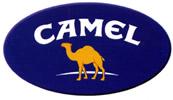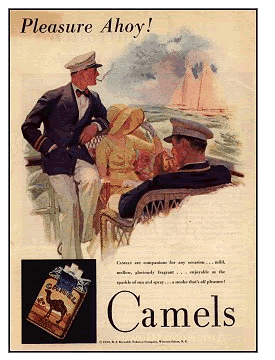 |
 All Classic Ads Vintage Collection - Camel related ads All Classic Ads Vintage Collection - Camel related ads
Ad • Ad

|
|
History of Camel Cigarettes (1913)
 Camel cigarettes are a brand, consisting of a blend of Turkish and American (Virginia) tobacco. Camel Cigarettes brand was introduced by U.S. company R.J.Reynolds tobacco (RJR) in 1913 and became R.J. Reynolds' first major cigarette brand and the country's first nationally marketed cigarette. Camel cigarettes have enjoyed nearly a century of outstanding success. Camel cigarettes are a brand, consisting of a blend of Turkish and American (Virginia) tobacco. Camel Cigarettes brand was introduced by U.S. company R.J.Reynolds tobacco (RJR) in 1913 and became R.J. Reynolds' first major cigarette brand and the country's first nationally marketed cigarette. Camel cigarettes have enjoyed nearly a century of outstanding success.
One of constituent parts of Camel cigarettes success is a combination of a high quality tobacco and the product's low price. They belong to 10best-selling cigarette brands. Camel Cigarettes were harmonized in a way to be smoked considerably easier in contrast to the much harsher brands popular in the period of their introduction. Balanced nicotine content and a smooth taste make Camel cigarettes a classic that will never run away.
Camel cigarettes were advance promoted, prior to official release, by a careful advertising campaign that included "teasers" which stated that "the Camels are coming" .This marketing style was, in fact, a prototype for attempts to sway public opinion that coincided with the United States' entry into the First World War, and later the Second World War. Another promotion strategy was the use of a Circus camel, 'Old Joe', which was driven through town and used to distribute free cigarettes. Old Joe was used as the model for the camel on the package.
It's interesting that though it's considered that the Camel image on the pack is of Egyptian origin, Turkish archives say it is a symbol of gratitude of Americans to Turkish for their 34 camels' donation to American Army in 1854. But R.J.Reynolds could hardly remember that in 1913, introducing Camel as his first major cigarette brand.
Winston-Salem, North Carolina, the city where R.J.R. was founded, was nicknamed "Camel City" at one time because of the brand's popularity.
From 1972-1993, Camel was the title sponsor of the popular auto racing series. It also sponsored the Lotus Formula One team and in the nineties, sponsored the factory Honda team in the AMA Superbike series.
Nowadays, Camel cigarettes represent three different families of flavor -- Classic, Turkish and Exotic Blends. The Classic styles, which represent the bulk of the brand's business, offer rich tobacco taste. Camel cigarettes' Turkish family offers smooth and mellow versions of the brand's distinctive flavor. Camel Exotic Blends, a line of premium-priced, limited-edition luxury blends, offer adult smokers indulgent taste signatures.
Camel is today one of the top five global cigarette brands, sold in over 90 countries worldwide.
In 1910, the most popular brands were Pall Mall, Sweet Caporals, Piedmont, Helmar and Fatima. By 1917 there are now 3 national brands of cigarettes on the US market: Lucky Strike, Camel cigarettes and Chesterfield.
In 1921, RJ Reynolds spends a whooping $8 million in advertising, mainly on Camel cigarettes. They also launch the highly successful "I'd Walk a Mile for a Camel" ad slogan. By 1923, Camel cigarettes control 45% of the U.S. cigarette market! The following year, Phillip Morris begins to push Marlboro cigarettes as a woman's cigarette that is a "Mild as May"!
By 1930, the most popular brands were Lucky Strike, Camel cigarettes, Chesterfield, Old Gold and Raleigh.
By 1940, Camel cigarettes take the lead as the most popular brands were Camel cigarettes, Lucky Strike, Chesterfield, Raleigh and Old Gold.
In 1950, the most popular brands are Camel cigarettes, Lucky Strike, Chesterfield, Commander and Old Gold, so not much change.
By 1970, Camel cigarettes dropped off the top five as the most popular brands were Winston, Pall Mall, Marlboro, Salem and Kool.
In 1987, R J Reynolds introduces Joe Camel. A North Carolina advertising agency uses Joe Camel to celebrate "Old Joe's" 75th anniversary. Four years later, the Journal of the American Medical Association publishes two reports on Joe Camel and kids. One study found that 91% of 6 year olds recognized Joe Camel, similar to the percent who recognized Mickey Mouse. The other study finds that since the inception of the Joe Camel campaign in 1987, Camel cigarettes share of the under 18 market has risen from 0.5% to 32.8%, worth more than $400 million per year in sales! The young character was portrayed as suave and sophisticated in different social settings, such as bars and pool halls. The campaign had helped to raise Camel cigarettes market share to 4.7% in 1996, from 4.4% in 1988, according to tobacco industry analysts.
As part of the industry’s settlement with state attorneys general, tobacco companies agreed to eliminate human and cartoon figures in advertising — a move that doomed both Camel cigarette's Joe Camel and Marlboro cigarette's Marlboro Man.
AVAILABLE Camel ADS BY DATE AND CATEGORY
1900 - 1919 |
1940 - 1949 |
1970 - 1979 |
|
|
|
1920 - 1929 |
1950 - 1959 |
1980 - 1989 |
|
|
|
1930 - 1939 |
1960 - 1969 |
1990 - 1999 |
|
|
|
 |
Size -
Grading -
Availability -
Price -
Publishing Date:
Magazine:
Shipping and handling fees - verify postal code
Catalog ID:

|
 |
Size -
Grading -
Availability -
Price -
Publishing Date:
Magazine:
Shipping and handling fees - verify postal code
Catalog ID:

|
|
|



